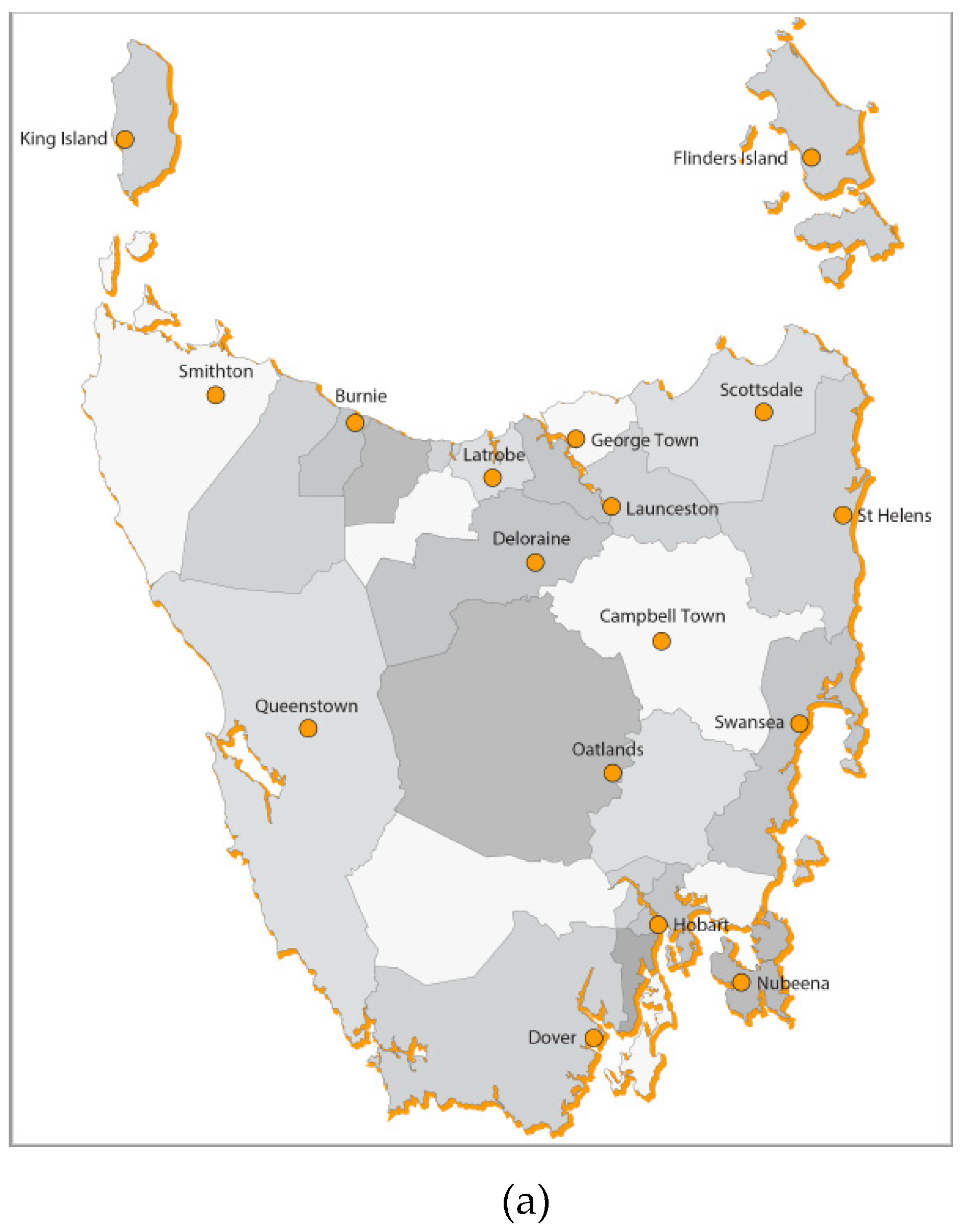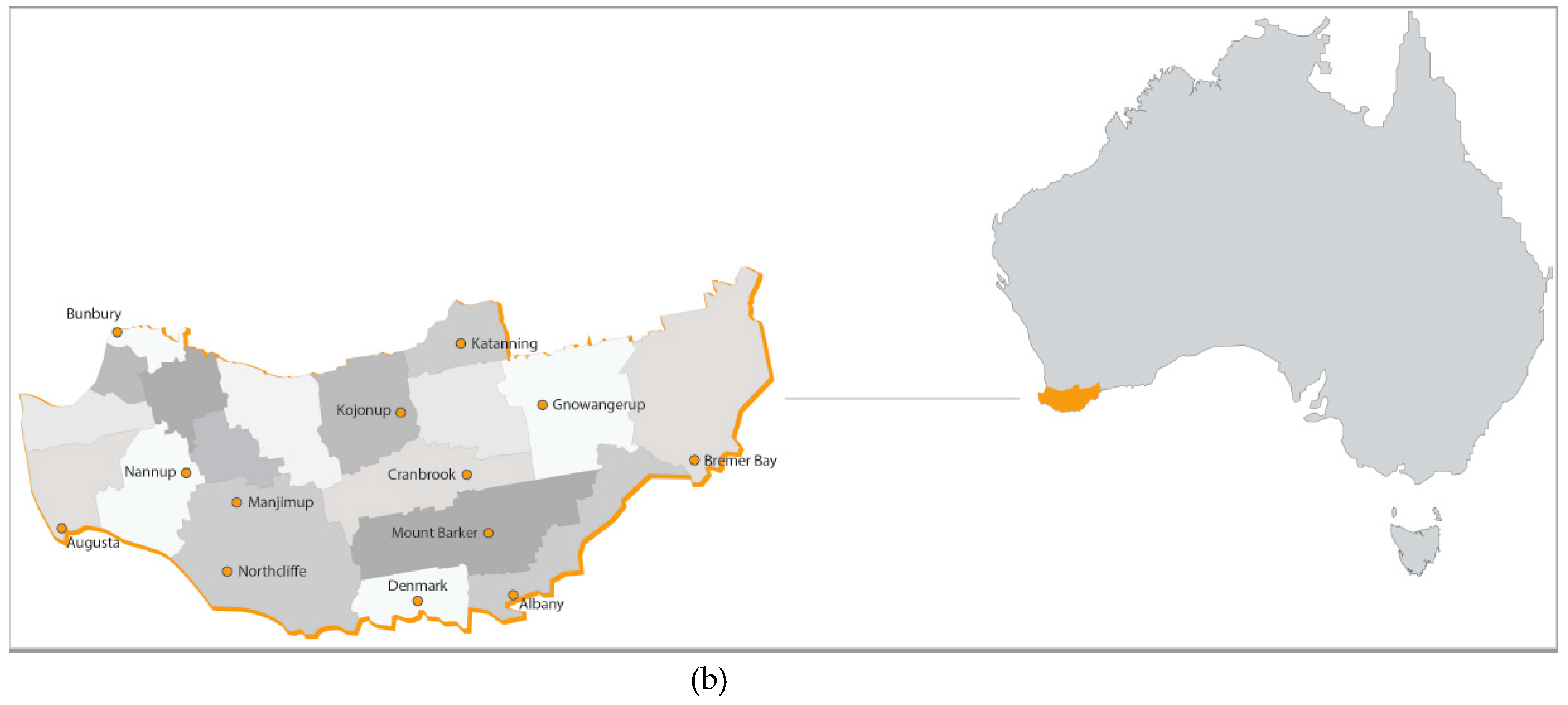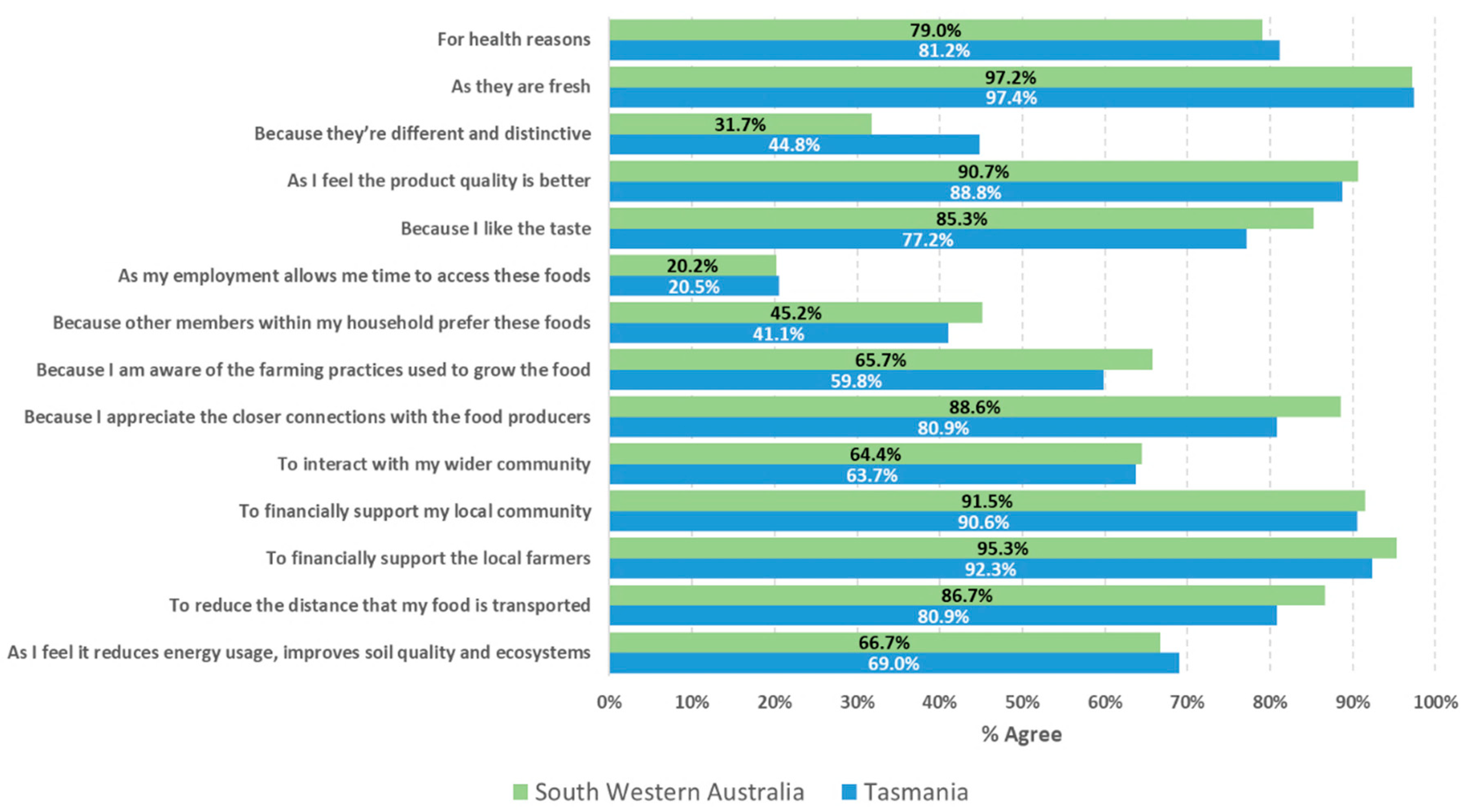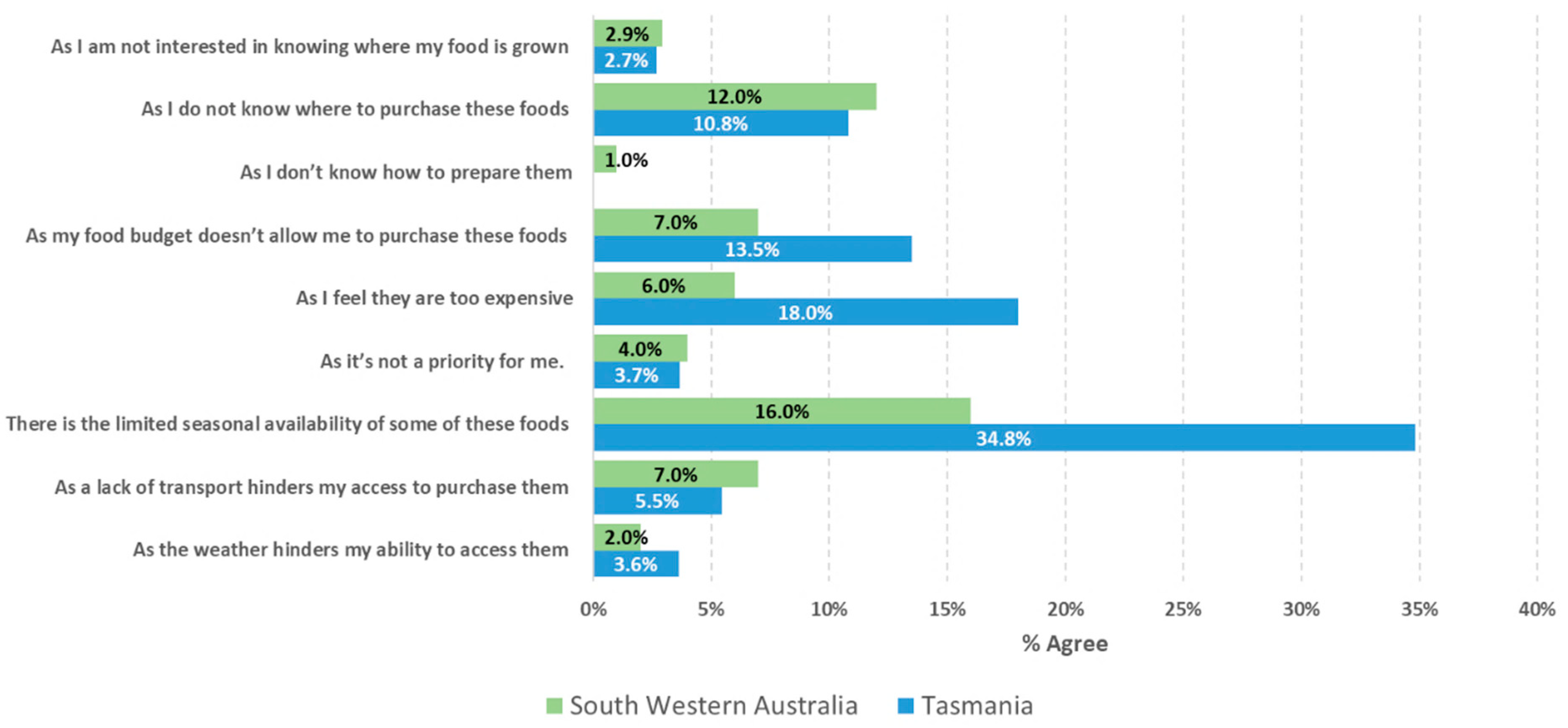Australian Consumer Perceptions of Regionally Grown Fruits and Vegetables: Importance, Enablers, and Barriers
Abstract
:1. Introduction
2. Materials and Methods
2.1. Study Sites
2.2. Questionnaire Development and Pilot Testing
2.3. Data Collection
2.4. Data Analysis
3. Results
3.1. Socio-Demographic Information
3.2. Fruit and Vegetable Consumption
3.3. Importance of Purchasing RGFFV
3.4. Enablers and Barriers for Purchasing RGFFV
3.5. Associations between Enablers/Barriers for Purchasing RGFFV and Respondents’ Socio-Demographic Characteristics
4. Discussion
4.1. Education, Policy, Practice, and Research Recommendations
4.2. Strengths and Limitations
5. Conclusions
Author Contributions
Funding
Acknowledgments
Conflicts of Interest
References
- Vegetables, W.A.; Planfarm Pty Ltd. Western Australia Vegetable Industry Benchmarks; VegetablesWA: Perth, Australia; Horticulture Innovation Australia Limited: Sydney, Australia, 2018. [Google Scholar]
- Blekkenhorst, L.C.; Bondonno, C.P.; Lewis, J.R.; Devine, A.; Woodman, R.J.; Croft, K.D.; Lim, W.H.; Beilin, L.J.; Prince, R.L.; Hodgson, J.M. Association of dietary nitrate with atherosclerotic vascular disease mortality: A prospective cohort study of older adult women. Am. J. Clin. Nutr. 2017, 106, 207–216. [Google Scholar] [CrossRef] [PubMed] [Green Version]
- Willett, W.; Rockström, J.; Loken, B.; Springmann, M.; Lang, T.; Vermeulen, S.; Garnett, T.; Tilman, D.; DeClerck, F.; Wood, A. Food in the Anthropocene: The EAT–Lancet Commission on healthy diets from sustainable food systems. Lancet 2019, 393, 447–492. [Google Scholar] [CrossRef]
- Live Lighter. In Season. Available online: https://livelighter.com.au/Eat-Brighter/In-season (accessed on 20 August 2019).
- Australian Institute of Health and Welfare. Australia’s Health 2018; Australian Institute of Health and Welfare: Canberra, Australia, 2018. [Google Scholar]
- Department of Agriculture. Food. Available online: http://www.agriculture.gov.au/ag-farm-food/food (accessed on 26 August 2019).
- Department of Infrastructure and Transport. State of Australian Cities 2013; Australian Government Department of Infrastructure and Transport: Canberra, Australia, 2013.
- Shirley, M. Food Ordinances: Encouraging Eating Local. William Mary Law Sch. Scholarsh. Repos. 2013, 37, 511–537. [Google Scholar]
- Tregear, A. Progressing knowledge in alternative and local food networks: Critical reflections and a research agenda. J. Rural Stud. 2011, 27, 419–430. [Google Scholar] [CrossRef] [Green Version]
- Dansero, E.; Puttilli, M. Multiple territorialities of alternative food networks: Six cases from Piedmont, Italy. Local Environ. 2014, 19, 626–643. [Google Scholar] [CrossRef]
- Renting, H.; Schermer, M.; Rossi, A. Building food democracy: Exploring civic food networks and newly emerging forms of food citizenship. Int. J. Sociol. Agric. Food 2012, 19, 289–307. [Google Scholar]
- Lamine, C.; Garçon, L.; Brunori, G. Territorial agrifood systems: A Franco-Italian contribution to the debates over alternative food networks in rural areas. J. Rural Stud. 2019, 68, 159–170. [Google Scholar] [CrossRef]
- Goodman, D.; Goodman, K. Alternative Food Networks. In International Encyclopedia of Human Geography; Elsevier: Oxford, UK, 2009; pp. 1–13. [Google Scholar]
- Martinez, S. Local Food Systems; Concepts, Impacts, and Issues; Diane Publishing: Collingdale, PA, USA, 2010. [Google Scholar]
- Renting, H.; Marsden, T.K.; Banks, J. Understanding alternative food networks: Exploring the role of short food supply chains in rural development. Environ. Plan. A 2003, 35, 393–411. [Google Scholar] [CrossRef] [Green Version]
- Aprile, M.C.; Caputo, V.; Nayga, R.M., Jr. Consumers’ preferences and attitudes toward local food products. J. Food Prod. Mark. 2016, 22, 19–42. [Google Scholar] [CrossRef]
- Bianchi, C.; Mortimer, G. Drivers of local food consumption: A comparative study. Br. Food J. 2015, 117, 2282–2299. [Google Scholar] [CrossRef] [Green Version]
- Penney, U.; Prior, C. Exploring the urban consumer’s perception of local food. Int. J. Retail Distrib. Manag. 2014, 42, 580–594. [Google Scholar] [CrossRef]
- Malak-Rawlikowska, A.; Majewski, E.; Wąs, A.; Borgen, S.O.; Csillag, P.; Donati, M.; Freeman, R.; Hoàng, V.; Lecoeur, J.L.; Mancini, M.C. Measuring the Economic, Environmental, and Social Sustainability of Short Food Supply Chains. Sustainability 2019, 11, 4004. [Google Scholar] [CrossRef] [Green Version]
- Delpeuch, F.; Maire, B.; Monnier, E.; Holdsworth, M. Globesity: A Planet Out of Control? Talor and Francis: New York, New York, USA, 2009. [Google Scholar]
- Feldmann, C.; Hamm, U. Consumers’ perceptions and preferences for local food: A review. Food Qual. Prefer. 2015, 40, 152–164. [Google Scholar] [CrossRef]
- Food Future, WA. Fresh Produce and Wine Consumer Survey; Perth NRM: Perth, Australia, 2019. [Google Scholar]
- Brown, E.; Dury, S.; Holdsworth, M. Motivations of consumers that use local, organic fruit and vegetable box schemes in Central England and Southern France. Appetite 2009, 53, 183–188. [Google Scholar] [CrossRef] [PubMed]
- Hempel, C.; Hamm, U. Local and/or organic: A study on consumer preferences for organic food and food from different origins. Int. J. Consum. Stud. 2016, 40, 732–741. [Google Scholar] [CrossRef]
- Zepeda, L.; Leviten-Reid, C. Consumers’ views on local food. J. Food Distrib. Res. 2004, 35, 1–6. [Google Scholar]
- Rushing, J.; Ruehle, J. Buying into the Local Food Movement; A.T. Kearney: New York, NY, USA, 2013. [Google Scholar]
- Nganje, W.E.; Hughner, R.S.; Patterson, P.M. Perception of risks and preferences for locally grown produce: A marketing system approach. J. Food Prod. Mark. 2014, 20, 196–214. [Google Scholar] [CrossRef]
- Cleveland, D.A.; Müller, N.M.; Tranovich, A.C.; Mazaroli, D.N.; Hinson, K. Local food hubs for alternative food systems: A case study from Santa Barbara County, California. J. Rural Stud. 2014, 35, 26–36. [Google Scholar] [CrossRef]
- Mundler, P.; Laughrea, S. The contributions of short food supply chains to territorial development: A study of three Quebec territories. J. Rural Stud. 2016, 45, 218–229. [Google Scholar] [CrossRef]
- O’Neill, K. Localized food systems–what role does place play? Reg. Stud. Reg. Sci. 2014, 1, 82–87. [Google Scholar] [CrossRef]
- Onyango, B.M.; Hallman, W.K.; Bellows, A.C. Purchasing organic food in US food systems: A study of attitudes and practice. Br. Food J. 2007, 109, 399–411. [Google Scholar] [CrossRef] [Green Version]
- Morris, C.; Buller, H. The local food sector: A preliminary assessment of its form and impact in Gloucestershire. Br. Food J. 2003, 105, 559–566. [Google Scholar] [CrossRef]
- Skallerud, K.; Wien, A.H. Preference for local food as a matter of helping behaviour: Insights from Norway. J. Rural Stud. 2019, 67, 79–88. [Google Scholar] [CrossRef]
- Farmer, J.R.; Betz, M.E. Rebuilding local foods in Appalachia: Variables affecting distribution methods of West Virginia farms. J. Rural Stud. 2016, 45, 34–42. [Google Scholar] [CrossRef] [Green Version]
- Department of Regional Development. Our WA Regions. Available online: http://www.drd.wa.gov.au/regions/Pages/default.aspx (accessed on 19 July 2019).
- Australian Bureau of Statistics. 1301.0—Year Book Australia, 2012—Agricultural Production. Available online: https://www.abs.gov.au/ausstats/abs@.nsf/Lookup/by%20Subject/1301.0~2012~Main%20Features~Agricultural%20production~260 (accessed on 20 August 2019).
- South West Development Commission. Agriculture. Available online: http://www.swdc.wa.gov.au/information-centre/statistics/agriculture.aspx (accessed on 20 August 2019).
- National Health and Medical Research Council. Serve Sizes. Available online: https://www.eatforhealth.gov.au/food-essentials/how-much-do-we-need-each-day/serve-sizes (accessed on 24 August 2019).
- Megicks, P.; Memery, J.; Angell, R.J. Understanding local food shopping: Unpacking the ethical dimension. J. Mark. Manag. 2012, 28, 264–289. [Google Scholar] [CrossRef]
- Arsil, P.; Sularso, K.E.; Mulyani, A. Factors influencing consumer preferences for locally produced food: A comparison between traditional and modern markets. Int. J. Eng. Technol. Sci. 2018, 7, 535–538. [Google Scholar] [CrossRef]
- Albrecht, C.; Smithers, J. Reconnecting through local food initiatives? Purpose, practice and conceptions of ‘value’. Agric. Hum. Values 2018, 35, 67–81. [Google Scholar] [CrossRef]
- Caspi, C.E.; Sorensen, G.; Subramanuan, S.V.; Kawachi, I. The local food environment and diet: A systematic review. Health Place 2012, 18, 1172–1187. [Google Scholar] [CrossRef] [Green Version]
- Feagan, R. The place of food: Mapping out the ‘local’in local food systems. Prog. Hum. Geogr. 2007, 31, 23–42. [Google Scholar] [CrossRef] [Green Version]
- Nurse Rainbolt, G.; Onozaka, Y.; McFadden, D.T. Consumer motivations and buying behavior: The case of the local food system movement. J. Food Prod. Mark. 2012, 18, 385–396. [Google Scholar] [CrossRef]
- Remar, D.; Campbell, J.; DiPietro, R.B. The impact of local food marketing on purchase decision and willingness to pay in a foodservice setting. J. Foodserv. Bus. Res. 2016, 19, 89–108. [Google Scholar] [CrossRef]
- Steptoe, A.; Pollard, T.M.; Wardle, J. Development of a measure of the motives underlying the selection of food: The food choice questionnaire. Appetite 1995, 25, 267–284. [Google Scholar] [CrossRef] [PubMed] [Green Version]
- Wilkins, J.L. Consumer perceptions of seasonal and local foods: A study in a US community. Ecol. Food Nutr. 2002, 41, 415–439. [Google Scholar] [CrossRef]
- Trivette, S. How local is local? Determining the boundaries of local food in practice. Agric. Hum. Values 2015, 32, 475–490. [Google Scholar] [CrossRef]
- Australian Bureau of Statistics. 4364.0.55.001—National Health Survey: First Results, 2017–2018. Available online: https://www.abs.gov.au/ausstats/abs@.nsf/Lookup/by%20Subject/4364.0.55.001~2017-18~Main%20Features~Key%20Findings%20%E2%80%94%20States%20and%20Territories~10001 (accessed on 4 June 2019).
- National Health and Medical Research Council. Australian Dietary Guidelines; National Health and Medical Research Council: Canberra, Australia, 2013.
- Australian Bureau of Statistics. 4364.0.55.012—Australian Health Survey: Consumption of Food Groups from the Australian Dietary Guidelines, 2011–2012; Australian Bureau of Statistics: Canberra, Australia, 2016.
- Kemp, K.; Insch, A.; Holdsworth, D.K.; Knight, J.G. Food miles: Do UK consumers actually care? Food Policy 2010, 35, 504–513. [Google Scholar] [CrossRef]
- Low, S.A.; Adalja, A.; Beaulieu, E.; Key, N.; Martinez, S.; Melton, A.; Perez, A. Trends in U.S. Local and Regional Food Systems; U.S. Department of Agriculture, Economic Research Service: Washington, DC, USA, 2015.
- Haynes-Maslow, L.; Parsons, S.; Wheeler, S.; Leone, L. A Qualitative Study of Perceived Barriers to Fruit and Vegetable Consumption Among Low-Income Populations, North Carolina, 2011. Prev. Chronic Dis. 2013, 10, E34. [Google Scholar] [CrossRef] [Green Version]
- Sambell, R.; Andrew, L.; Godrich, S.; Wolfgang, J.; Vandenbroeck, D.; Stubley, K.; Rose, N.; Newman, L.; Horwitz, P.; Devine, A. Local Challenges and Successes Associated with Transitioning to Sustainable Food System Practices for a West Australian Context: Multi-Sector Stakeholder Perceptions. Int. J. Environ. Res. Public Health 2019, 16, 2051. [Google Scholar] [CrossRef] [Green Version]
- Government of Western Australia. First Interim State Public Health Plan for Western Australia; Department of Health WA: Perth, Australia, 2017.
- Christensen, L.O.; Jablonski, B.B.R.; O’Hara, J.K. School districts and their local food supply chains. Renew. Agric. Food Syst. 2019, 34, 207–215. [Google Scholar] [CrossRef]
- Dunning, R.; Day, J.; Creamer, N. Local sourcing and the military: Lessons learned through a university-based initiative to increase local procurement at a US military base. Renew. Agric. Food Syst. 2019, 34, 250–258. [Google Scholar] [CrossRef] [Green Version]
- Kendra, K.; Ariane, M. The Farm Fresh Healthcare Project: Analysis of a Hybrid Values-based Supply Chain. J. Agric. Food Syst. Community Dev. 2014, 5, 57–74. [Google Scholar] [CrossRef] [Green Version]
- Boys, K.A.; Fraser, A.M. Linking small fruit and vegetable farmers and institutional foodservice operations: Marketing challenges and considerations. Renew. Agric. Food Syst. 2019, 34, 226–238. [Google Scholar] [CrossRef]
- Goodman, D.; DuPuis, E.M.; Goodman, M.K. Alternative food networks: Knowledge, practice, and politics; Routledge: Abingdon, UK, 2012. [Google Scholar]
- Michel-Villarreal, R.; Hingley, M.; Canavari, M.; Bregoli, I. Sustainability in alternative food networks: A systematic literature review. Sustainability 2019, 11, 859. [Google Scholar] [CrossRef] [Green Version]




| Agricultural Production ($m) | WA (Total) [36] | SW WA [37] | TAS [36] |
|---|---|---|---|
| Fruit and nuts (excluding grapes) | 217.1 | 129.4 | 83.4 |
| Grapes | 112.5 | 41.8 | 19.0 |
| Vegetables | 316.1 | 101.7 | 233.1 |
| Total Agriculture | 5752.8 | - | 1078.9 |
| Variable | Category | TAS | SWA | Overall | p-Value |
|---|---|---|---|---|---|
| Age in years a | 18–30 | 27 (23.1%) | 14 (15.6%) | 41 (19.8%) | 0.642 |
| 31–40 | 20 (17.1%) | 17 (18.9%) | 37 (17.9%) | ||
| 41–50 | 25 (21.4%) | 17 (18.9%) | 42 (20.3%) | ||
| 51–60 | 16 (13.7%) | 15 (16.7%) | 31 (15.0%) | ||
| ≥61 | 29 (24.8%) | 27 (30%) | 56 (27.1%) | ||
| Gender a | Male | 36 (30.5%) | 20 (22.2%) | 56 (26.9%) | 0.182 |
| Female | 82 (69.5%) | 70 (77.8%) | 152 (73.1%) | ||
| Education a | Secondary | 21 (17.8%) | 24 (26.7%) | 45 (21.6%) | 0.124 |
| Tertiary | 97 (82.2%) | 66 (73.3%) | 163 (78.4%) | ||
| Household income a | <20,000–40,000 | 16 (14.3%) | 18 (20.5%) | 34 (17.0%) | 0.507 |
| 40,000–60,000 | 16 (14.3%) | 16 (18.2%) | 32 (16.0%) | ||
| 60,000–80,000 | 20 (17.9%) | 14 (15.9%) | 34 (17.0%) | ||
| 80,000–100,000+ | 60 (53.6%) | 40 (45.5%) | 100 (50.0%) | ||
| Number of Adults a | 1 | 10 (8.5%) | 19 (21.1%) | 29 (13.9%) | 0.018 * |
| 2 | 82 (69.5%) | 59 (65.6%) | 141 (67.8%) | ||
| 3 or more | 26 (22%) | 12 (13.3%) | 38 (18.3%) | ||
| mean ± SD | 2.2 ± 0.6 | 2.0 ± 0.7 | 2.1 ± 0.7 | ||
| Number of dependents/children a | 0 | 60 (54.1%) | 58 (65.9%) | 118 (59.3%) | 0.244 * |
| 1 | 14 (12.6%) | 12 (13.6%) | 26 (13.1%) | ||
| 2 | 26 (23.4%) | 13 (14.8%) | 39 (19.6%) | ||
| 3 or more | 11 (9.9%) | 5 (5.7%) | 16 (8.0%) | ||
| mean ± SD | 0.9 ± 1.2 | 0.64 ± 1.1 | 0.8 ± 1.1 | ||
| Main shopper a | Yes | 87 (75.0%) | 104 (93.7%) | 191 (84.1%) | <0.001 ** |
| No | 29 (25.0%) | 7 (6.3%) | 36 (15.9%) | ||
| Self-reported fruit in serves/day b | 1 or less | 50 (42.0%) | 5 (4.4%) | 55 (23.6%) | <0.001 ** |
| 2 | 42 (35.3%) | 34 (29.8%) | 76 (32.6%) | ||
| 3 | 21 (17.6%) | 45 (39.5%) | 66 (28.3%) | ||
| 4 | 2 (1.7%) | 20 (17.5%) | 22 (9.4%) | ||
| 5 or more | 4 (3.4%) | 10 (8.8%) | 14 (6.0%) | ||
| Median (Q1, Q3) | 2 (1, 2) | 3 (2, 4) | 2 (2, 3) | ||
| Self-reported vegetables in in serves/day b | 2 | 10 (9.1%) | 3 (2.6%) | 13 (5.8%) | <0.001 ** |
| 3 | 31 (28.2%) | 12 (10.5%) | 43 (19.2%) | ||
| 4 | 32 (29.1%) | 37 (32.5%) | 69 (30.8%) | ||
| 5 | 25 (22.7%) | 25 (21.9%) | 50 (22.3%) | ||
| 6 | 12 (10.9%) | 37 (32.5%) | 49 (21.9%) | ||
| Median (Q1, Q3) | 4 (3, 5) | 5 (4, 6) | 4 (3.25, 5) |
| Variable | Category | TAS | SWA | Overall | ||||||
|---|---|---|---|---|---|---|---|---|---|---|
| Important | Not Important | p-Value | Important | Not Important | p-Value | Important | Not Important | p-Value | ||
| Age | 18–30 | 25 (92.6%) | 2 (7.4%) | 0.533 | 14 (100%) | 0 (0.0%) | 0.369 | 39 (95.1%) | 2 (4.9%) | 0.692 |
| 31–40 | 20 (100%) | 0 (0.0%) | 16 (94.1%) | 1 (5.9%) | 36 (97.3%) | 1 (2.7%) | ||||
| 41–50 | 23 (92.0%) | 2 (8.0%) | 17 (100%) | 0 (0.0%) | 40 (95.2%) | 2 (4.8%) | ||||
| 51–60 | 16 (100%) | 0 (0.0%) | 15 (100%) | 0 (0.0%) | 31 (100%) | 0 (0.0%) | ||||
| ≥61 | 28 (96.6%) | 1 (3.4%) | 26 (100%) | 0 (0.0%) | 54 (98.2%) | 1 (1.8%) | ||||
| Total | 112 (95.7%) | 5 (4.3%) | 88 (98.9%) | 1 (1.1%) | 200 (97.1%) | 6 (2.9%) | ||||
| Gender | Male | 33 (91.7%) | 3 (8.3%) | 0.143 | 19 (100%) | 0 (0.0%) | 0.600 | 52 (94.5%) | 3 (5.5%) | 0.187 |
| Female | 80 (97.6%) | 2 (2.4%) | 69 (98.6%) | 1 (1.4%) | 149 (98.0%) | 3 (2.0%) | ||||
| Total | 113 (95.8%) | 5 (4.2%) | 88 (98.9%) | 1 (1.1%) | 201 (97.1%) | 6 (2.9%) | ||||
| Education | Secondary | 21 (100%) | 0 (0.0%) | 0.288 | 24 (100%) | 0 (0.0%) | 0.541 | 45 (100%) | 0 (0%) | 0.190 |
| Tertiary | 92 (94.8%) | 5 (5.2%) | 64 (98.5%) | 1 (1.5%) | 156 (96.3%) | 6 (3.7%) | ||||
| Total | 113 (95.8%) | 5 (4.2%) | 88 (98.9%) | 1 (1.1%) | 201 (97.1%) | 6 (2.9%) | ||||
| Household income | <20,000–40,000 | 16 (100%) | 0 (0.0%) | 0.266 | 17 (100%) | 0 (0.0%) | 0.153 | 33 (100%) | 0 (0.0%) | 0.061 |
| 40,000–60,000 | 15 (93.8%) | 1 (6.3%) | 16 (100%) | 0 (0.0%) | 31 (96.9%) | 1 (3.1%) | ||||
| 60,000–80,000 | 18 (90.0%) | 2 (10.0%) | 13 (92.9%) | 1 (7.1%) | 31 (91.2%) | 3 (8.8%) | ||||
| 80,000–100,000+ | 59 (98.3%) | 1 (1.7%) | 40 (100%) | 0 (0.0%) | 99 (99.0%) | 1 (1.0%) | ||||
| Total | 108 (96.4%) | 4 (3.6%) | 86 (98.9%) | 1 (1.1%) | 194 (97.5%) | 5 (2.5%) | ||||
| Main shopper | No | 26 (89.7%) | 3 (10.3%) | 0.065 | 7 (100%) | 0 (0.0%) | 0.793 | 33 (91.7%) | 3 (8.3%) | 0.021 * |
| Yes | 85 (97.7%) | 2 (2.3%) | 102 (99%) | 1 (1.0%) | 187 (98.4%) | 3 (1.6%) | ||||
| Total | 111 (95.7%) | 5 (4.3%) | 109 (99.1%) | 1 (0.9%) | 220 (97.3%) | 6 (2.7%) | ||||
| Enabler 1 | Factor 1 (20.1%) | Factor 2 (17.7%) | Factor 3 (15.6%) | Factor 4 (12.9%) |
| For health reasons | 0.545 | |||
| As they are fresh | 0.641 | |||
| Because they’re different and distinctive | ||||
| As I feel the product quality is better | 0.831 | |||
| Because I like the taste | 0.712 | |||
| As my employment allows me time to access these foods | 0.834 | |||
| Because other members within my household prefer these foods | 0.707 | |||
| Because I am aware of the farming practices used to grow the food | ||||
| Because I appreciate the closer connections with the food producers | 0.698 | |||
| To interact with my wider community | 0.694 | |||
| To financially support my local community | 0.837 | |||
| To financially support the local farmers | 0.803 | |||
| To reduce the distance that my food is transported | 0.843 | |||
| As I feel it reduces energy usage, improves soil quality and ecosystems | 0.775 | |||
| Barrier 1 | Factor 1 (22.6%) | Factor 2 (20.7%) | Factor 3 (20.4%) | Factor 4 (15.1%) |
| As I am not interested in knowing where my food is grown | 0.879 | |||
| As I do not know where to purchase these foods | 0.552 | |||
| As I don’t know how to prepare them | 0.562 | |||
| As my food budget doesn’t allow me to purchase these foods | 0.867 | |||
| As I feel they are too expensive | 0.855 | |||
| As it’s not a priority for me. | 0.551 | |||
| As the limited seasonal availability of some of these foods prevents me from accessing, purchasing and consuming them | 0.899 | |||
| As a lack of transport hinders my access to purchase them | 0.851 | |||
| As the weather hinders my ability to access them | 0.828 |
© 2019 by the authors. Licensee MDPI, Basel, Switzerland. This article is an open access article distributed under the terms and conditions of the Creative Commons Attribution (CC BY) license (http://creativecommons.org/licenses/by/4.0/).
Share and Cite
Godrich, S.; Kent, K.; Murray, S.; Auckland, S.; Lo, J.; Blekkenhorst, L.; Penrose, B.; Devine, A. Australian Consumer Perceptions of Regionally Grown Fruits and Vegetables: Importance, Enablers, and Barriers. Int. J. Environ. Res. Public Health 2020, 17, 63. https://doi.org/10.3390/ijerph17010063
Godrich S, Kent K, Murray S, Auckland S, Lo J, Blekkenhorst L, Penrose B, Devine A. Australian Consumer Perceptions of Regionally Grown Fruits and Vegetables: Importance, Enablers, and Barriers. International Journal of Environmental Research and Public Health. 2020; 17(1):63. https://doi.org/10.3390/ijerph17010063
Chicago/Turabian StyleGodrich, Stephanie, Katherine Kent, Sandra Murray, Stuart Auckland, Johnny Lo, Lauren Blekkenhorst, Beth Penrose, and Amanda Devine. 2020. "Australian Consumer Perceptions of Regionally Grown Fruits and Vegetables: Importance, Enablers, and Barriers" International Journal of Environmental Research and Public Health 17, no. 1: 63. https://doi.org/10.3390/ijerph17010063
APA StyleGodrich, S., Kent, K., Murray, S., Auckland, S., Lo, J., Blekkenhorst, L., Penrose, B., & Devine, A. (2020). Australian Consumer Perceptions of Regionally Grown Fruits and Vegetables: Importance, Enablers, and Barriers. International Journal of Environmental Research and Public Health, 17(1), 63. https://doi.org/10.3390/ijerph17010063





